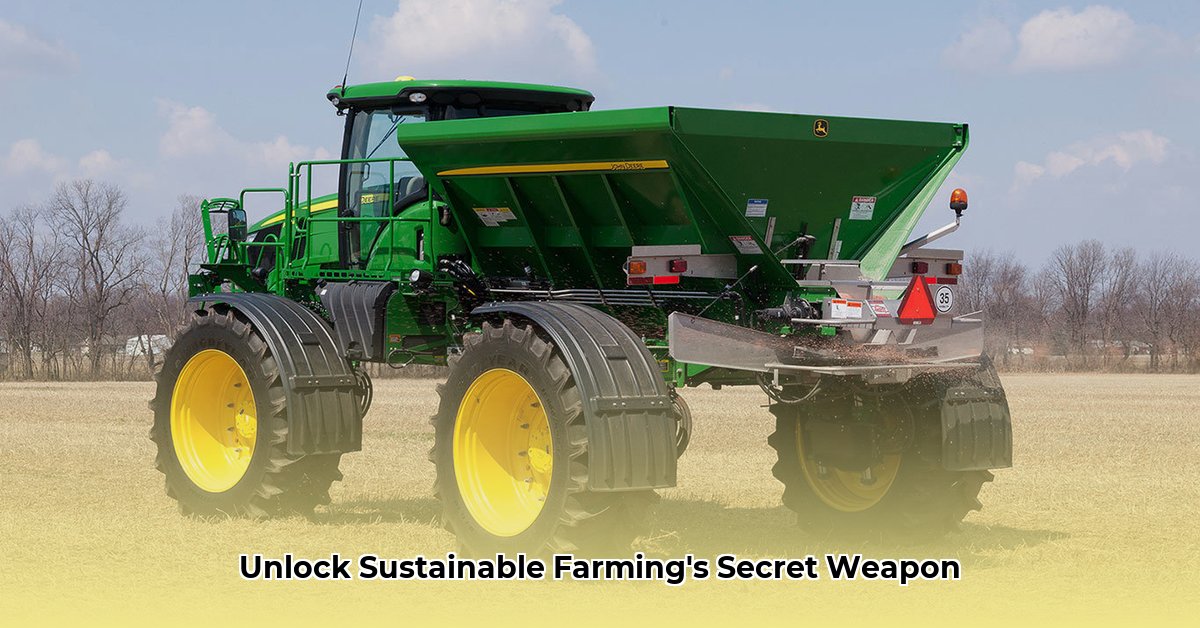
Precision agriculture is revolutionizing farming, and at the heart of this revolution lies the humble tractor spreader. This isn't just about spreading fertilizer; it's about optimizing resource use, boosting yields, and safeguarding our environment. For more information on pull-behind spreaders, check out this helpful resource: pull-behind spreaders. This comprehensive guide will equip you with the knowledge and skills to leverage tractor spreaders for sustainable farming success.
Smart Fertilizing: Precision for Profit and the Planet
Traditional fertilizer application is often wasteful, akin to scattering handfuls of seed to the wind. Much of the fertilizer is lost to runoff, leaching, or simply doesn't reach the plants. Precision fertilizer application, however, is like surgically placing each seed where it will thrive. This targeted approach significantly reduces waste, minimizes environmental damage, and improves yield efficiency. Doesn't that sound like a win-win-win?
Tractor spreaders, especially those equipped with GPS technology, enable variable-rate application (VRA). VRA allows farmers to adjust fertilizer output in real-time based on soil conditions and crop needs. This granular control reduces fertilizer overuse and associated environmental concerns like water pollution from nutrient runoff. But how effective is VRA in practice? Studies have shown that VRA can reduce fertilizer use by up to 30%, leading to significant cost savings and environmental gains.
Choosing the Right Spreader: Finding Your Perfect Match
Selecting the right spreader is critical for optimal performance and return on investment. Consider these key factors:
Spreader Type: Centrifugal vs. Pneumatic
- Centrifugal spreaders: These are generally less expensive and easier to maintain. However, they may lack the precision of other types.
- Pneumatic spreaders: These offer greater precision, allowing for more accurate fertilizer placement and reduced waste. They require more specialized knowledge and are typically more costly.
"The choice between centrifugal and pneumatic spreaders depends entirely on the scale and specific needs of the operation," says Dr. Emily Carter, Agricultural Engineering Professor at Cornell University. "Small farms might find centrifugal spreaders perfectly adequate, while larger operations will likely benefit from the increased precision of pneumatic spreaders."
Size and Capacity
Choose a spreader that's appropriately sized for your field sizes and typical fertilizer application needs. Consider future expansion to ensure adaptability.
Technology Features
GPS guidance, automatic calibration, and real-time monitoring features significantly enhance precision and efficiency. However, these features often increase the initial cost.
Budget
Spreaders vary widely in price. Consider your budget, prioritizing features that offer the best return on investment. Don't forget to explore leasing or purchasing second-hand options to reduce upfront costs.
Calibrating and Maintaining Your Spreader: Ensuring Accuracy and Efficiency
Accurate calibration is paramount for precise fertilizer application. Follow these steps meticulously:
- Select a Test Area: Choose a flat, uniform area.
- Weigh Fertilizer: Carefully weigh a known amount of fertilizer.
- Spread and Collect: Spread the fertilizer and collect the material after spreading.
- Calculate Application Rate: Compare the amount spread against the intended rate.
- Adjust Settings: Fine-tune spreader settings until the application rate is accurate.
Regular maintenance, including inspecting belts, bearings, and spread patterns, will guarantee peak performance and longevity. Ignoring this can lead to inconsistent application and potentially damage the equipment. Isn’t it better to invest time in regular maintenance preventing potential costly repairs?
Best Practices for Application: Maximizing Yield and Minimizing Impact
Effective fertilizer application involves more than just the machine. Consider these best practices:
- Optimal Timing: Applying fertilizer at the right growth stages maximizes nutrient uptake.
- Soil Conditions: Soil type, moisture levels, and nutrient content significantly impact fertilizer requirements.
- Weather Considerations: Avoid windy conditions, as wind can significantly reduce the efficiency of application.
By adhering to the above best practices, you increase the likelihood of achieving optimal yield while minimizing environmental impact. Remember, these practices form the cornerstone of sustainable agriculture.
Data-Driven Decisions: Leveraging Technology for Maximum Efficiency
GPS-enabled spreaders offer a wealth of data, including the precise application rate and location of applied fertilizer. Analyzing this data helps to:
- Optimize Fertilizer Use: Identify areas requiring higher or lower rates.
- Refine Application Strategies: Improve efficiency and reduce overlap.
- Enhance Yield: Correlate fertilizer application patterns with crop response.
"The data collected by GPS spreaders is invaluable," claims Mark Olsen, Chief Agronomist at Heartland Farms. "It allows us to make data-driven decisions, ensuring maximum yield while minimizing environmental impact." The long-term benefits of data-driven decision making outweigh the initial investment.
Safety Considerations: Prioritizing Safe Operation
Safety should always be paramount when operating or maintaining your spreader:
- Appropriate Safety Gear: Wear protective clothing, eye protection, and gloves.
- Pre-Operation Inspection: Thoroughly inspect the spreader before each use.
- Proper Training: Seek professional training if needed.
- Safe Storage: Store fertilizer safely.
Failing to adhere to safety protocols can lead to safety incidents and equipment damage. Isn't preserving your health and equipment a worthy goal?
Weighing the Pros and Cons: Is a Tractor Spreader Right for You?
| Pros | Cons |
|---|---|
| Reduced fertilizer waste | High initial investment |
| Increased yield efficiency | Requires training and expertise |
| Minimized environmental impact | Potential for technical malfunctions |
| Improved fertilizer use monitoring | Data management complexity |
| Optimized nutrient application | Dependence on technology and infrastructure |
The decision to invest in a tractor spreader depends on your specific needs and resources. However, the benefits in terms of increased efficiency, reduced environmental impact, and improved profitability are substantial and make a strong case for its adoption. The future of sustainable agriculture will likely have these machines at its forefront.